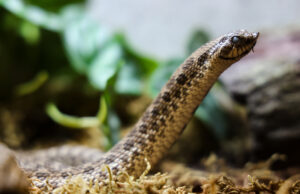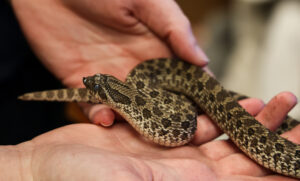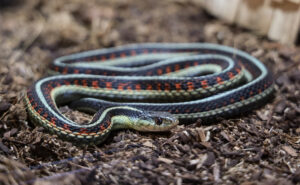Dogwood Canyon Blog
Scales of the Ozarks
August 14, 2024

Spring has officially sprung, and that means creatures and critters of all kinds will be out and about in the canyon – including snakes! Dogwood Canyon is focused on connecting and educating our visitors about nature with the help of our ambassador animals which include our scaly friends.
Our Nature & Conservation Center is home to a few snakes who are native to Missouri and, as ambassadors, they help guests learn more about their diet, habitats, and how they respond to threats.
Dogwood Canyon is a 10,000-acre outdoor playground for all kinds of wildlife that call it home. You never know what you will find while on our trails or adventuring through the backcountry. It is important to know that coming across the occasional snake is a possibility, but there is no need to be frightened!
First up is Pumba, a plains hog-nosed snake, who is known for her sassy but sweet attitude. Hog-nosed snakes have a unique nose compared to other snakes. They get their name due to their upturned nose which resembles a pig’s snout. They are found in dry, flat lands and use their noses like a shovel to sift and burrow themselves in loose soil and sand.


Plains hog-nosed snakes have always been somewhat uncommon in Missouri, but in recent years, they have not been seen at all. They are currently listed as a ‘Species of Conservation Concern’ according to Missouri’s Department of Conservation. Their overall specialized habitat range stretches from parts of Canada, down south through the Great Plains and even west to New Mexico and Texas. Due to the loss of habitat from urbanization and other environmental factors, however, this species faces threats to their long-term existence.
Beans, a western ratsnake, may have an intimidating appearance, but he is quite harmless! Dogwood Canyon’s education team describes him as “sweet and docile” most of the time, but like most of us, he does have days where he prefers to be left alone.

Western ratsnakes are one of Missouri’s largest and most common species of snakes. Beans is almost 7 feet in length, an average size for his species, but some western ratsnakes can grow to lengths up to 8 feet. Ratsnakes primarily dwell in woodlands, forests, and rocky, wooded hillsides and brush piles. Their main food source is mice, which is why they are commonly found hiding in farm buildings and old houses looking for a meal.
Western ratsnakes are most active from April to October, and you can expect to see them out and about during the daytime hunting for prey. On warmer days, they adjust to the rising temperatures and become nocturnal to avoid extreme heat. While at Dogwood Canyon, you may find ratsnakes hanging around the creeks taking a drink or scouring the ground for shelter in brush piles or hollow trees.
Our final friend is Nevel, a plains gartersnake. Nevel has a nervous and reserved temperament, and since this species are known for their speed, he is not shy to show off his quick moves when handled.

Gartersnakes prefer grassland habitats and reside in wet prairies, marshes, lakes, ponds, and streams. During their active months, which range from March to late October, you may find them basking in the sun near the creeks in the canyon soaking up the Vitamin D they missed out on all winter.
Missouri is also home to midland and northern watersnakes. They are commonly found in the canyon and throughout the Ozarks. Unfortunately, these snakes are often mistaken for the northen cottonmouth – a highly venomous snake. Watersnakes are extremely beneficial to the environment. They improve fishing by eating dead or dying fish which prevents the spread of diseases.
Their diet helps prevent overpopulation of small aquatic animals such as frogs, salamanders, and tadpoles. On the other hand, young watersnakes are a food source for large game fish species like musky, pike, and catfish. They are valuable to the ecosystems they dwell in and provide a symbiotic relationship for other animals to help these habitats thrive.
If you happen to encounter a snake while at Dogwood Canyon, or anywhere outdoors, we encourage you to let them be; snakes should not be feared, but rather respected. As for our ambassador snakes, during your next visit, we hope you will stop by and say hello to Pumba, Beans, and Nevel just above the general store!
